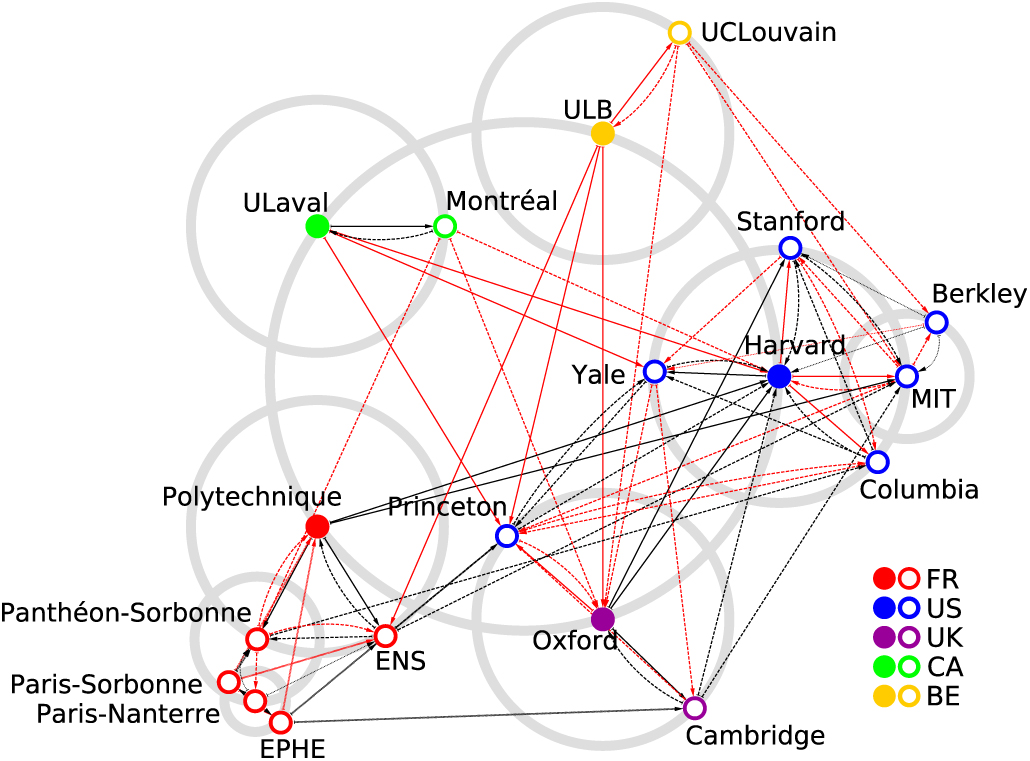News
EPJ Plus article on microfiber pollution in the air selected for Springer Nature Grand Challenges Programme
- Details
- Published on 28 January 2019

A new study reports on microplastic fibres in the air, which can potentially enter the human body through breathing.
Microplastics (MPs) are one of the major hot topics in environmental science. Scientists have started to investigate the impact of such pollutants in different habitats, such as oceans, rivers, soils and air. Several studies have shown that MP fibers are very common in the atmosphere. They are invisible to human eye as they are smaller than 5 mm. These fibers, which derive from different sources, float freely in the air pushed by winds. A recent study, published on EPJ Plus, evaluated microfiber pollution in the air of an intercity terminal and a university campus in the Sakarya Province, Turkey.
EPJ B Highlight - New university ranking system includes the cultural perspective
- Details
- Published on 25 January 2019

A new study proposes a new way of ranking universities, using a more balanced cultural view and based on 24 international editions of Wikipedia
Scientists in France have developed a new way of generating a ranking of the world’s universities that places more emphasis on the cultural perspective. In a recent study published in EPJ B, Célestin Coquidé and José Lages, affiliated with the multidisciplinary research institute UTINAM in Besançon, and Dima Shepelyansky from the CNRS in Toulouse, France, perform an analysis of Wikipedia editions in 24 languages, collected in May 2017 - previous studies pursuing a similar approach focused on data from 2013. Employing well-known ranking algorithms, they establish a Wikipedia Ranking of World Universities based on the relative cultural views of each of the 24 language-specific Wikipedia editions. Thus, they provide a more balanced view that reflects the standpoints of different cultures.
EPJ D Highlight - Better safeguards for sensitive information
- Details
- Published on 23 January 2019

Study improves the lower boundary and secret key capacity of an encryption channel
The secure encryption of information units based on a method called quantum key distribution (QKD) involves distributing secret keys between two parties - namely, Alice, the sender, and Bob, the receiver - by using quantum systems as information carriers. However, the most advanced quantum technology, QKD, is currently limited by the channel's capacity to send or share secret bits. In a recent study published in EPJ D, Gan Wang, who is affiliated with both Peking University, Bejing, China, and the University of York, UK, and colleagues show how to better approach the secret key capacity by improving the channel's lower boundary.
EPJ D Highlight - Quantifying how much quantum information can be eavesdropped
- Details
- Published on 22 January 2019

New study yields more precise characterisation of monogamous and polygamous entanglement of quantum information units
Encrypted communication is achieved by sending quantum information in basic units called quantum bits, or qubits. The most basic type of quantum information processing is quantum entanglement. However, this process remains poorly understood. Better controlling quantum entanglement could help to improve quantum teleportation, the development of quantum computers, and quantum cryptography. Now, a team of Chinese physicists have focused on finding ways to enhance the reliability of quantum secret sharing. In a new study published in EPJ D, Zhaonan Zhang from Shaanxi Normal University, Xi'an, China, and colleagues provide a much finer characterisation of the distributions of entanglement in multi-qubit systems than previously available. In the context of quantum cryptography, these findings can be used to estimate the quantity of information an eavesdropper can capture regarding the secret encryption key.
EPJ Data Science Highlight - Twitter’s tampered samples: Limitations of big data sampling in social media
- Details
- Published on 16 January 2019

Social networks are widely used as sources of data in computational social science studies, and so it is of particular importance to determine whether these datasets are bias-free. In EPJ Data Science, Jürgen Pfeffer, Katja Mayer and Fred Morstatter demonstrate how Twitter’s sampling mechanism is prone to manipulation that could influence how researchers, journalists, marketeers and policy analysts interpret their data.
(Guest post by Jürgen Pfeffer, Katja Mayer and Fred Morstatter, originally published in the SpringerOpen blog)
EPJ E Highlight - How ion adsorption affects biological membranes’ functions
- Details
- Published on 15 January 2019

A new study presents new models describing how the adsorption of calcium, barium and strontium ions onto biological membranes may affect the functions of cells
Ions with two positive electrical charges, such as calcium ions, play a key role in biological cell membranes. The adsorption of ions in solution onto the membrane surface is so significant that it affects the structural and functional properties of the biological cells. Specifically, ions interact with surface molecules such as a double layer of lipids, or liposomes, formed from phosphatidylcholines (PC). In a new study published in EPJ E, Izabela Dobrzyńska from the University of Białystok, Poland, develops a mathematical model describing the electrical properties of biological membranes when ions such as calcium, barium and strontium adsorb onto them at different pH levels. Her works helps shed light on how ion adsorption reduces the effective surface concentration of add-on molecules with a specific function that can take part in biochemical reactions. These factors need to be taken into account when studying the diverse phenomena that occur at the lipid membrane in living cells, such as ion transport mechanisms.
EPJ A Highlight - Lattice Improvement in Lattice Effective Field Theory
- Details
- Published on 11 January 2019

Lattice calculations using the framework of effective field theory have been applied to a wide range of few-body and many-body systems. One of the challenges of these calculations is to remove systematic errors arising from the nonzero lattice spacing. While the lattice improvement program pioneered by Symanzik provides a formalism for doing this and has already been utilized in lattice effective field theory calculations, the effectiveness of the improvement program has not been systematically benchmarked.
In this work lattice improvement is used to remove lattice errors for a one-dimensional system of bosons with zero-range interactions. To this aim the improved lattice action up to next-to-next-to-leading order is constructed and it is verified that the remaining errors scale as the fourth power of the lattice spacing for observables involving as many as five particles. These results provide a guide for increasing the accuracy of future calculations in lattice effective field theory with improved lattice actions.
EPJ C - New Editor-in-Chief for Experimental Physics I: Accelerator Based High-Energy Physics
- Details
- Published on 09 January 2019

The publishers of The European Physical Journal C – Particles and Fields are pleased to announce the appointment of Professor Günther Dissertori as new Editor-in-Chief for Experimental Physics I: Accelerator Based High-Energy Physics, replacing Professor Jos Engelen as of 1 January 2019.
Günther Dissertori obtained his PhD in Physics for a thesis on theoretical studies and experimental data analyses related to the ALEPH experiment at the CERN electron-positron collider LEP. He is Full Professor and Head of the Institute for Particle Physics and Astrophysics at ETH Zürich. Currently, the main focus of his research group is on the analysis of data taken with the CMS detector and its future upgrade, as well as on applications of particle physics detector technologies to bio-medical imaging, in particular positron emission tomography.
EPJ Plus Highlight - 3D virtual slicing of an antique violin reveals ancient varnishing methods
- Details
- Published on 08 January 2019

Physicists and chemists use 3D scanning to unlock the forgotten secrets of the multi-layered coating methods that give violins their exceptional tone and look
Italian violin-making masters of the distant past developed varnishing techniques that lent their instruments both an excellent musical tone and impressive appearance. Few records from this era have survived, as techniques were most often passed down orally to apprentices; only scarce information is available on the original methods used for finishing the instruments. In a new study published in EPJ Plus, Giacomo Fiocco, affiliated with both Pavia and Torino Universities in Italy, and his colleagues use the synchrotron facility in Trieste to develop a non-invasive 3D-scanning approach that yields insights into the main morphological features of the overlapping finishing layers used on violins. In turn, the morphological images can be used to determine the chemical nature of the coating. This newly developed method could help scientists rediscover the procedures and materials used, and reproduce the multi-layered coating methods of the ancient masters.
20 Years of EPJ
- Details
- Published on 19 December 2018

This year has seen the 20th anniversary of the founding of EPJ, the European Physical Journal. We would like to thank all our editors, authors, referees and readers for contributing to EPJ’s success.
Merry Christmas and Happy New Year!
The EPJ Publishers





